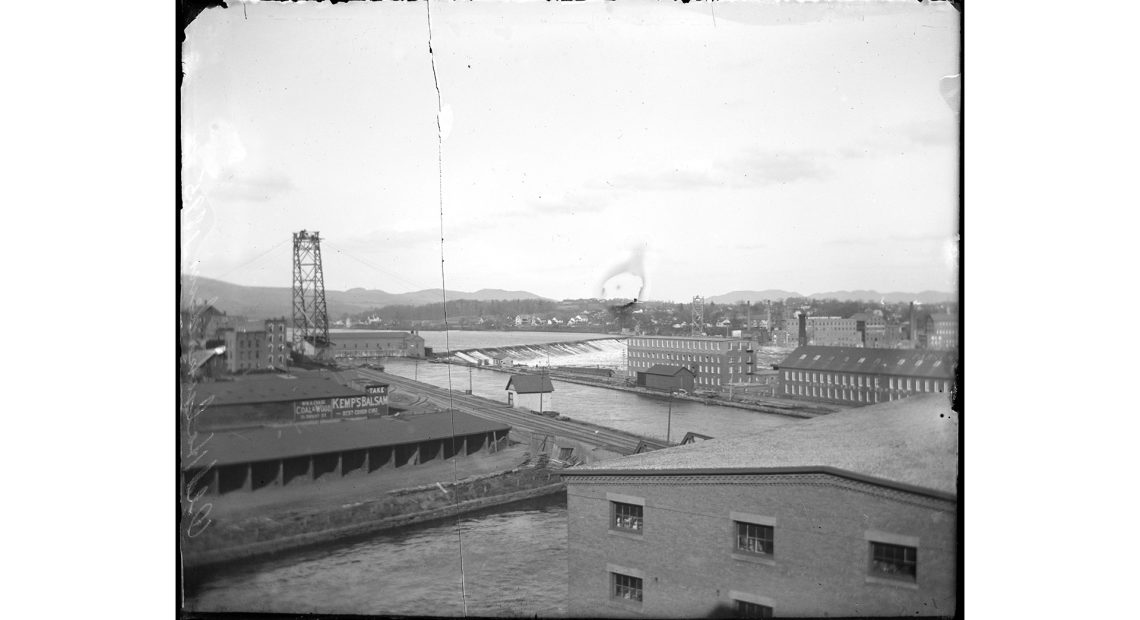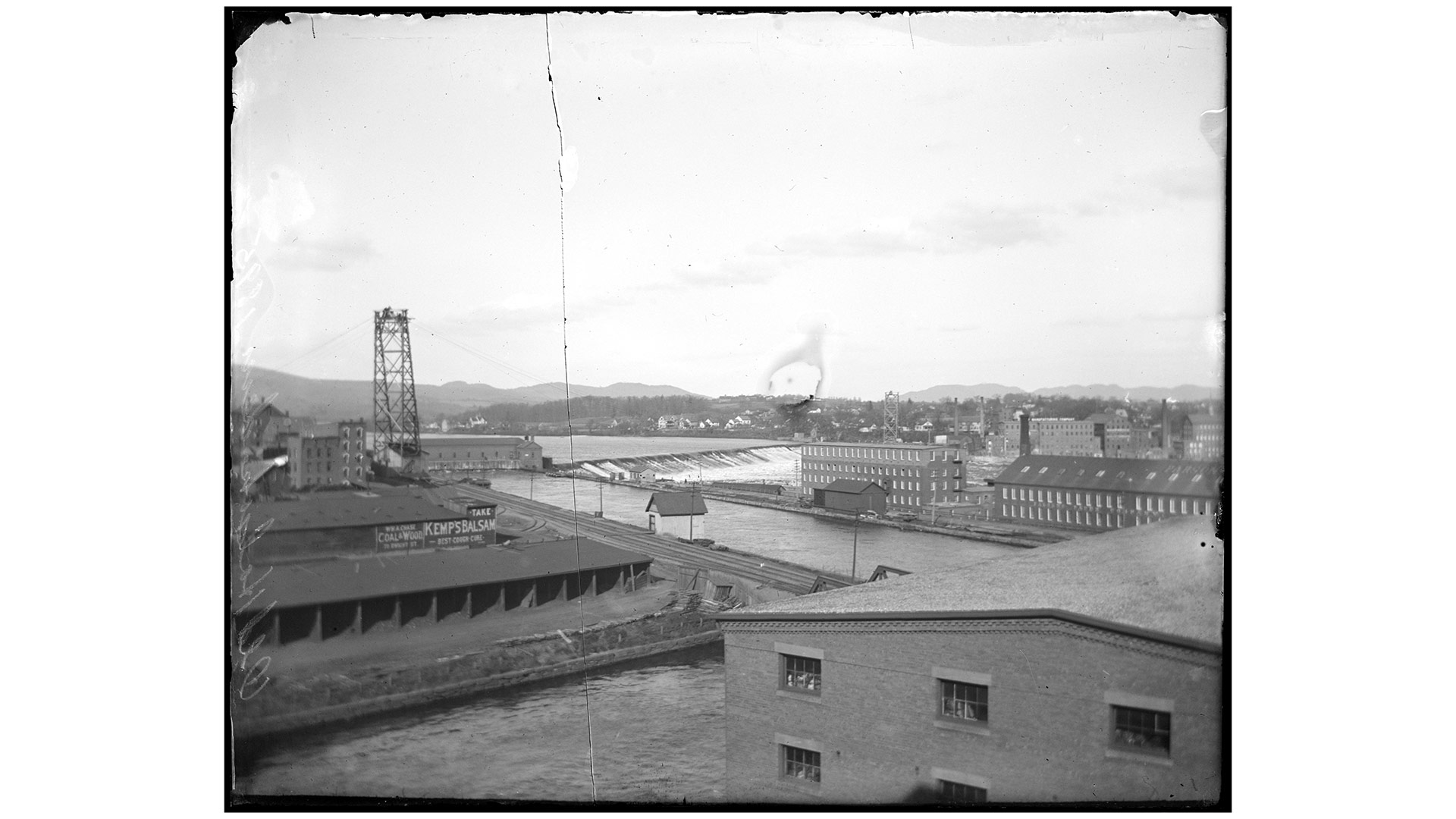
Holyoke’s History Is One of Adaptation, Evolution, and Water
Going with the Flow
By Joseph Bednar

Old Holyoke Dam
The city of Holyoke’s website details a series of telegrams sent by one James Mills on Nov. 6, 1848 to a group of industrialists in Boston who had invested in the first dam at South Hadley Falls and were eager to hear of its performance.
“The gates were closed and the water filling behind the dam,” Mills reported at 10 a.m. It would be his only happy missive.
Noon: “Dam leaking badly.”
1 p.m.: “Leaks cannot be stopped.”
2 p.m.: “Bulkheads are giving way.”
3:20 p.m.: “Dam gone to hell by way of Willimansett.”
So, it wasn’t the most auspicious way to begin Holyoke’s new direction as a planned industrial city that harnessed the power of the Connecticut River.
But the builders learned from their mistakes — and built a replacement dam. Like the first, it was also made of wood and completed the following summer. This dam still stands, 150 feet underwater, behind the current, modern stone dam that was put into service in 1900.
This bit of history is just one example of Holyoke not only overcoming challenges, but evolving with them along a winding, intriguing, still-evolving story.
The story actually begins much earlier, with the Indigenous tribes who settled there on the rich, alluvial plain, including the Nonotucks, from whom early European settlers eventually purchased the land that would be incorporated into the future boundaries of Holyoke.
Captain Elizur Holyoke is believed to be the first European to explore the future city. In 1633, he led an expedition up the Connecticut River to explore the potential for settlement. Two years later, based upon his report, European agriculture settlement began in the region. Initially concentrated in Springfield, settlers soon began to migrate to the surrounding areas that would later become West Springfield, Chicopee, and Holyoke. Holyoke was then known as Ireland Parish, a name that would remain in common use until 1850.
When Boston investors saw in the parish industrial potential similar to Lawrence and Lowell — and the energy potential of the river — they set out to create an industrial city on a large scale.
In 1847, taking advantage of the broad plain and the 57-foot drop in the Connecticut River at South Hadley Falls, work began on the planned industrial city. Canals, mills, boarding houses, offices, and a dam were all built by pick and shovel. And on March 4, 1850, Holyoke — with its working dam — was finally separated from West Springfield and designated its own town.
“There was some resistance from the farmers who initially didn’t want to sell their land,” said Penni Martorell, Holyoke’s city historian and curator of Wistariahurst. “But eventually [the investors] won out. They just bought the land and then laid out the plan for the city. The flats area was definitely the working man’s area. The middle area around the canals was where the factories were built, and then the highlands were set aside for retail businesses and homes of the wealthier families.”
Strength in Paper
Before the planned-city idea got rolling, Holyoke was mainly an agricultural community with a sprinkling of industry, including a lumber mill on the river.
“The investors had had success in Lawrence, in getting mills set up along the river up there. And then they were like, ‘well, where else can we go?’” Martorell told BusinessWest. “Lawrence and Lowell often lay claim to being the first planned industrial cities. We say they worked it out there, and then they perfected it here in Holyoke. They really took advantage of the 60-foot drop in the river, how to harness that energy and then send it through the canals.”
Holyoke’s development was rapid, with its population surging from about 3,200 in 1850 to 45,000 by the turn of the century and more than 60,000 at its peak in the early 1920s. Textiles were the first major product of the city, quickly followed by paper, which became the dominant force in the city. At one time, more than 25 paper mills were in operation.
By 1885, 12 years after its official designation as a city, Holyoke was the largest single producer of paper of any city in the U.S., producing around 190 tons per day, more than double the next-largest producer, Philadelphia, which produced 69 tons per day despite having a population nearly 40 times its size. By 1900, Holyoke would produce about 320 tons per day, predominantly writing paper, led by American Pad & Paper Co., American Writing Paper Co., and others.
Holyoke also built schools, churches, parks, and many public buildings, including the historic City Hall (see story on page 28). By the turn of the century, Holyoke exerted considerable influence on American life. The Holyoke Opera House was the test location for Broadway plays before moving on to New York. The Easter parade here drew as many spectators as on Fifth Avenue.
A number of industrial inventions arose out of the city in the late 19th and early 20th centuries. The first and most prominent hydraulic testing lab in the U.S., Holyoke Testing Flume, performed 3,176 tests to establish turbine efficiency from 1870 to 1932. Other pioneering developments included the first use of Hans Goldschmidt’s exothermic welding process in the Americas in 1904, by George Pellissier and the Holyoke Street Railway. In electronics, the world’s first commercial toll line, between the city’s Hotel Jess and a location in Springfield, entered service in 1878. Holyoke was also home to Thaddeus Cahill’s New England Electric Music Co., which, in 1906, demonstrated the telharmonium, the world’s first electromechanical instrument, a predecessor of the synthesizer.
Meanwhile, the availability of water power enabled Holyoke to support its own electric utility company and maintain it independently of America’s major regional utilities. The city was thus a rare unaffected area in the Northeast blackout of 1965.
But the city’s second century has been a complicated story, Martorell said.
“It was boom and bust. So every time there was a bust, the wealthier people were able to prepare for that. But the lower-income people were not able to prepare. They would move on to wherever there was work. So it was a bit of transience at certain points. The paper industry kind of morphed into other industrial spaces.”
Northern Migration
Beginning at the end of World War II, the city’s demographics began to change, as an influx of Puerto Ricans and other Latino groups began to migrate to the Northeast U.S., driven largely by the Farm Labor Program initiated by the U.S. Department of Labor, which recruited Puerto Rican laborers to work on agricultural land; in the case of Holyoke, many worked on tobacco farms and arrived in the city in search of better job opportunities at the mills, as previous generations had.
“In Springfield and Holyoke, housing was inexpensive, you had access to 91 and 95, and a lot of them had an agricultural background and were looking for farm work,” Martorell said of the Puerto Rican influx. “So between Hatfield and the tobacco fields along the Connecticut River, they were able to find work pretty quickly once they got here.”
By 1970, the number of Puerto Rican residents numbered around 5,000; however, by that time, many faced a city economy that was struggling. Holyoke’s mills had closed due to the changing economic landscape of early globalization and deindustrialization; from 1955 to 1970, half of all industrial jobs vanished. Despite economic and social difficulties, however, the population grew significantly, and today Latinos form the city’s largest minority group, with the largest Puerto Rican population per capita of any American city outside Puerto Rico proper, at 44.7%.
As for those old industrial buildings, their use is evolving.
“The Skinners, who made silk, sold their company to Indian Head Mills, which was a conglomerate going around buying up textile mills in the late 1950s or early 1960s. They bought the company and then shut it down a few years later,” Martorell said. “And many of the other paper companies had already gone out. Parsons Paper was the first paper company in Holyoke, and they closed their doors in 2005. So that was a pretty good run.”
A few specialty paper and printing companies remain, but today, many of the old mills along the canals are being repurposed, from cannabis cultivation, manufacturing, and retail operations to the entertainment venue known as Gateway City Arts.
Martorell said change has been a constant in Holyoke, but so has a feeling of promise.
“People in Holyoke love Holyoke. People are committed to being here, and they want to see good things happen for the city,” she told BusinessWest. “And I think the last two mayors have really tried to make an effort to rebrand the city in a more positive way and say that the challenges that we’ve had in the past have made us stronger and more diverse. So we embrace that and celebrate that.”
Some information for this article was adapted from the city of Holyoke’s written history and from Wikipedia.





